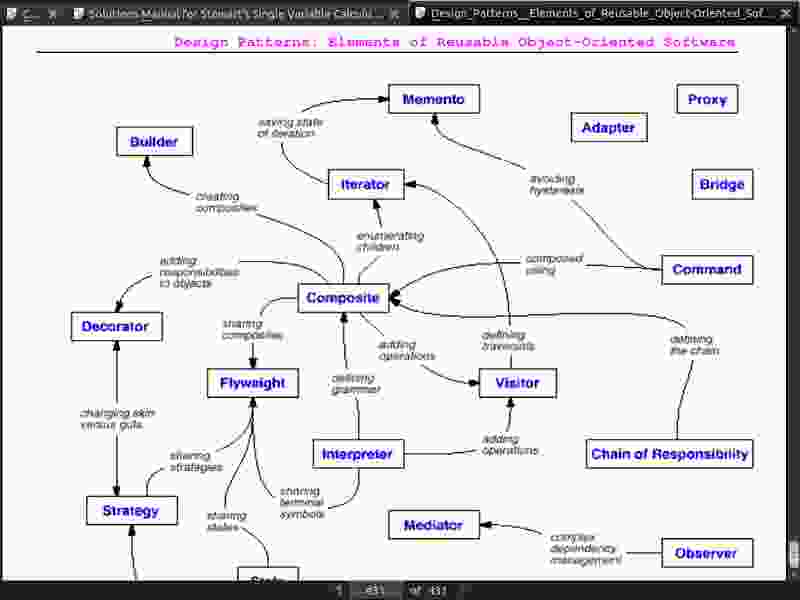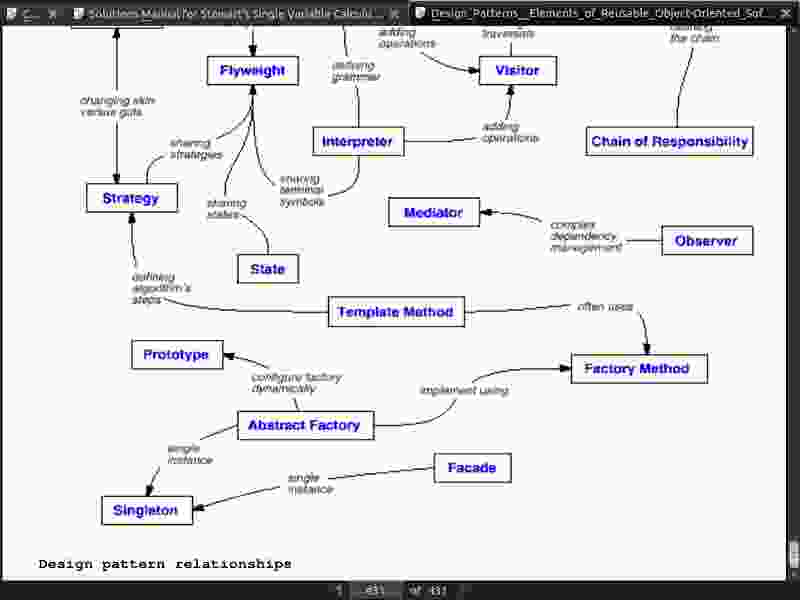Home · Book Reports · 2018 · Design Patterns - Elements of Reusable Object-Oriented Software

- Author :: Erich Gamma, Richard Helm, Ralph Johnson, John Vlissides
- Publication Year :: 1994
- Read Date :: 2018-09-13
- Source :: Design_Patterns__Elements_of_Reusable_Object-Oriented_Software(1994).pdf
designates my notes. / designates important.
Thoughts
Overall this was a great book. I will keep it in mind as the go-to resource if I ever need a refresher on what pattern I might want to use in a situation where the answer is not obvious.
I really like the layout, with each section offering motivation, theory, structure, example code (in C++ and Smalltalk), and related patterns.
In hindsight I can say that the authors succeeded in their goal of introducing a common language so that developers could communicate at a higher level. 25+ years after its publication it is still a valuable resource and we still use the names the authors assigned to the various patterns.
Chapter one introduces the book itself. What is it? A catalog of design patterns.
Experience shows us that we do a lot of the same things, solving similar problems, again and again. This book tries to put down what those similar solutions look like, describe them, and name them.
The four essential parts of a pattern are its name, what problem it addresses, the solution it offers, and what consequences it has.
There are three main types of patterns, creational, structural, and behavioral. The book is divided into chapters covering each of these high level types.
The old stand-by is reiterated.
Program to an interface not an implementation.
They also see, quite early, that composition is at least as good, and today I think most would agree better, than inheritance.
The authors offer some advice on how to use the catalog, how to choose patterns, and how to go about implementing a pattern. Like some other books I have read, the make a point that name selection based on the context you are working is is absolutely key. In my opinion naming, of functions and variables, is probably the most important aspect of software design.
Chapter two is a case study in the design of a simple document editor that includes such things as glyphs, analysis (spell checking and formatting), layout, and the UI. This is used throughout the book to help motivate several of the patterns. Here it is used to introduce 8 patterns: composition, decorators, strategy, abstract factory, bridge, command, iterator, and visitor.
Chapters three, four, and five are the design pattern catalog.
Chapter three covers the creational patterns, including abstract factories, builders, prototypes, and singletons.
Chapter four covers the structural patterns, including composite, adapter (wrapper), proxy, flyweight, facade, bridge, and decorator.
Most of these patterns are similar/related, but apply to different problems.
For example, the adapter and bridge are almost the same, but used at different points in development. The adapter is used later in development to stick together two things that weren’t foreseen to go together while the bridge sticks them together from the onset, understanding that they will be evolved independently but must work together.
Chapter five covers the behavioral patterns, including chain of responsibility (event handler), command, memento, observer (publish-subscribe), mediator, iterator, interpreter, strategy, template, and visitor.
The state pattern is presented with an example of TCP connections and drawing programs where each tool is a state.
Overall I think this is a must-read for any software developer. Even with its age it is still as relevant today as it has ever been.
On the other hand, I see more functional programming on the horizon, given multi-core processors being the trend that will be followed for the foreseeable future (since we’ve about reached the limit in terms of speed and size for a single core). Still, I think the ideas here are as useful to a functional designer, even if they won’t be implemented in the same way.
Further Reading
- Christopher Alexander is the architect who first studied patterns in buildings and communities and developed a “pattern language” for generating them.
Exceptional Excepts
Table of Contents
- 01: Introduction
- 02: A Case Study: Design a Document Editor
- 03: Creational Patterns
- 04: Structural Patterns
- 05: Behavioral Patterns
- 06: Conclusion
Design Pattern Catalog
- Pages numbers from the actual book.
· 01: Introduction
page 15:
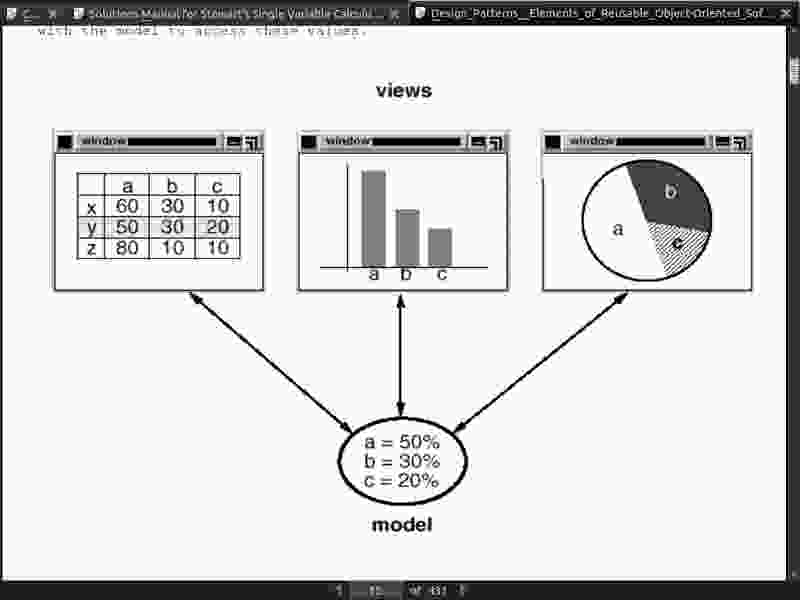
page 21:
- Patterns can have either creational, structural, or behavioral purpose. Creational patterns concern the process of object creation. Structural patterns deal with the composition of classes or objects. Behavioral patterns characterize the ways in which classes or objects interact and distribute responsibility.
page 22:
-
Class patterns deal with relationships between classes and their subclasses. These relationships are established through inheritance, so they are static—fixed at compile-time. Object patterns deal with object relationships, which can be changed at run-time and are more dynamic. Almost all patterns use inheritance to some extent. So the only patterns labeled “class patterns” are those that focus on class relationships. Note that most patterns are in the Object scope.
-
Creational class patterns defer some part of object creation to subclasses, while Creational object patterns defer it to another object. The Structural class patterns use inheritance to compose classes, while the Structural object patterns describe ways to assemble objects. The Behavioral class patterns use inheritance to describe algorithms and flow of control, whereas the Behavioral object patterns describe how a group of objects cooperate to perform a task that no single object can carry out alone.
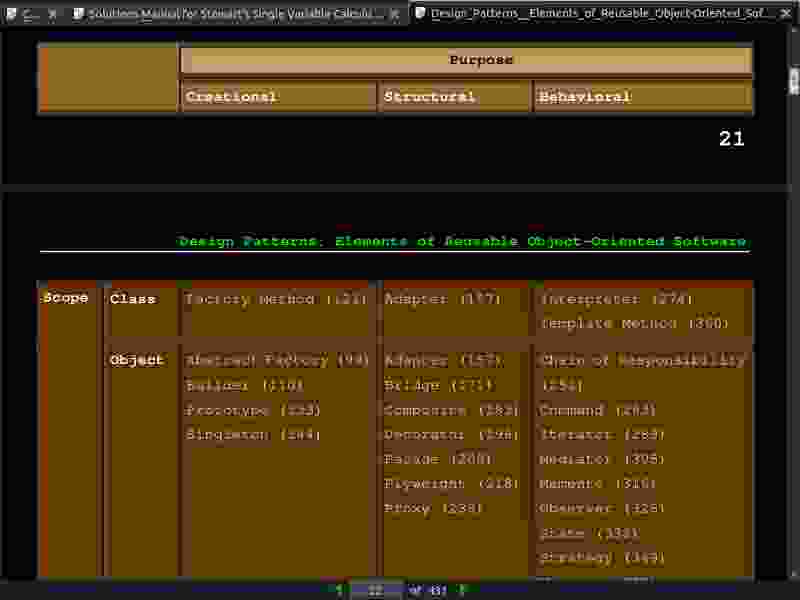
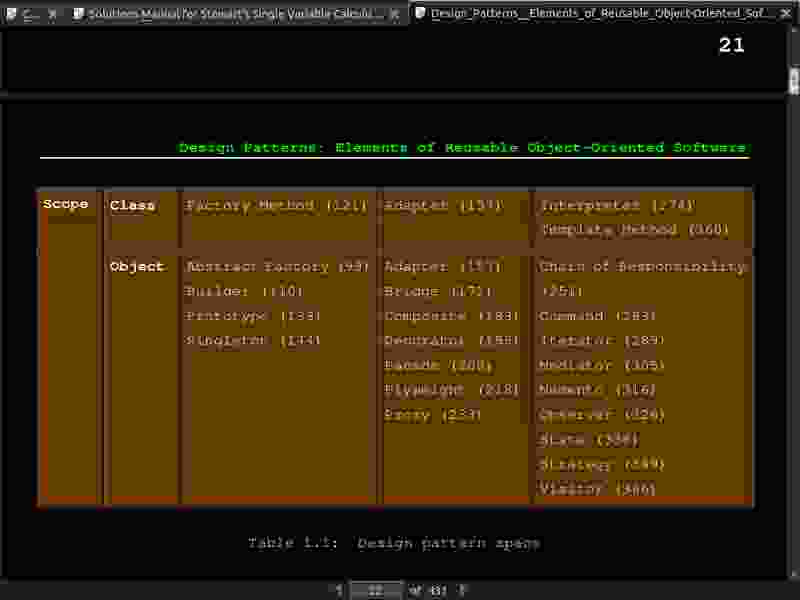
page 23:
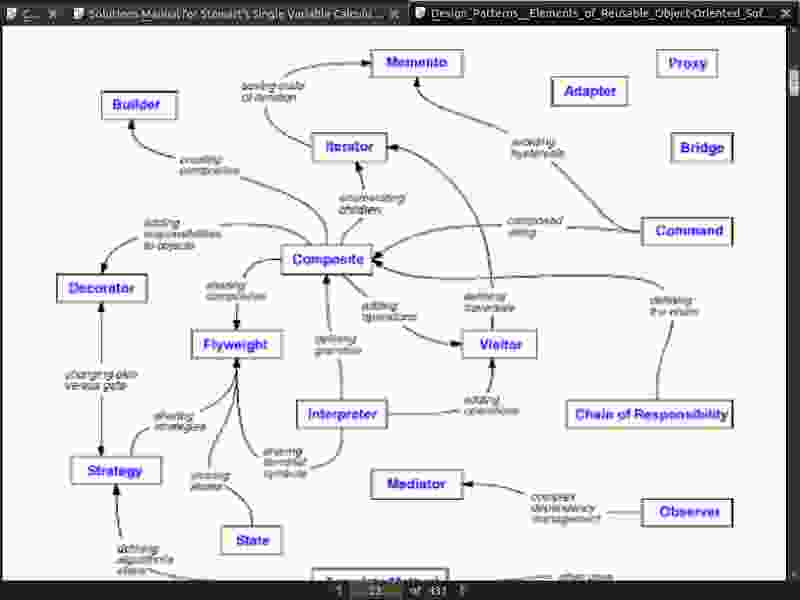
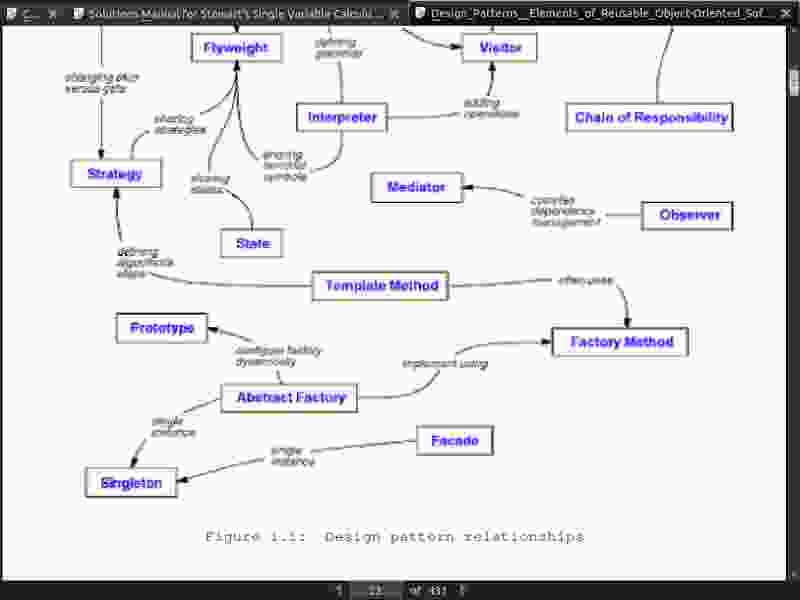
page 30:
-
Program to an interface not an implementation.
-
I wonder if this is where this comes from or if they are simply restating it.
page 31:
-
Composition is discussed as an alternative to inheritance.
-
it’s often said that “inheritance breaks encapsulation” [Sny86]. The implementation of a subclass becomes so bound up with the implementation of its parent class that any change in the parent’s implementation will force the subclass to change.
page 32:
- Favor object composition over class inheritance.
· 02: A Case Study: Design a Document Editor
page 43:
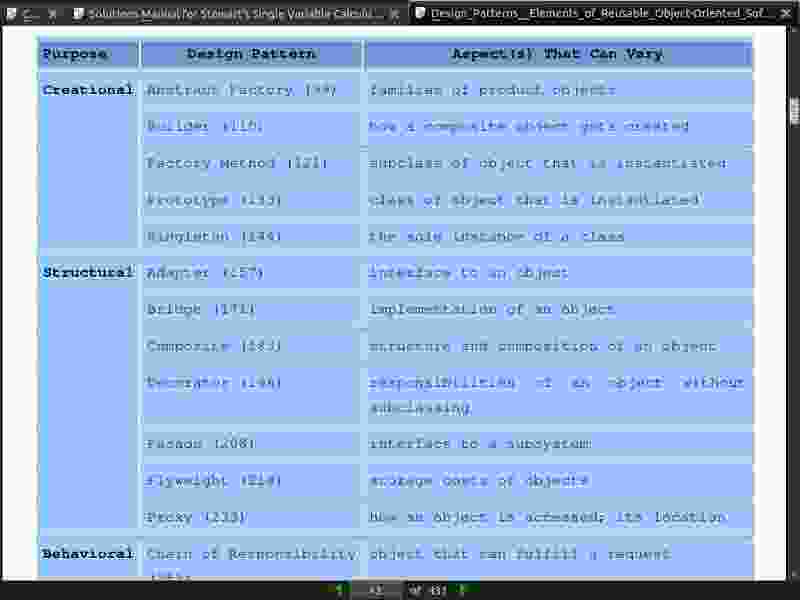
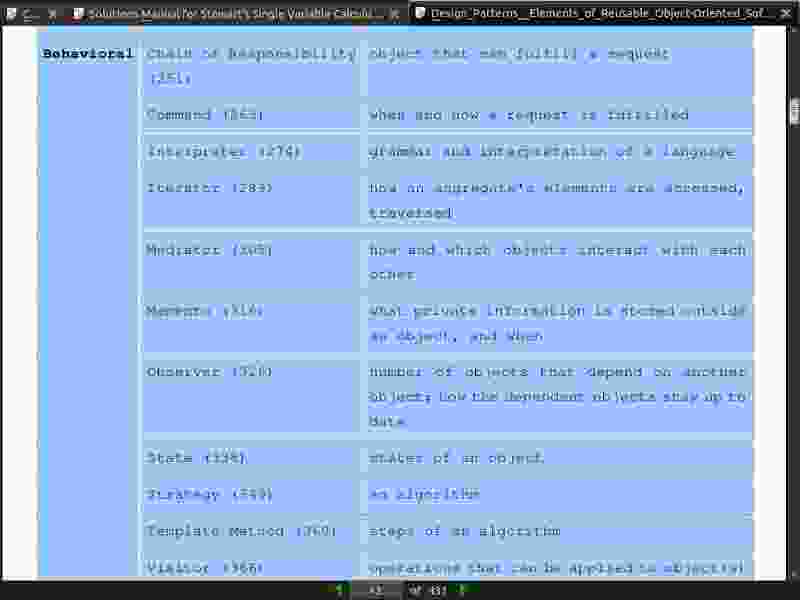
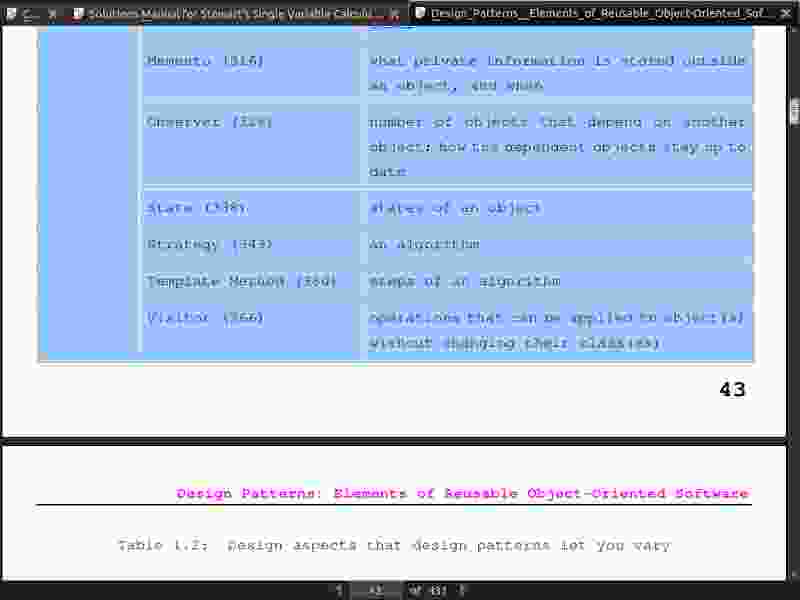
Design Pattern Catalog
· 03: Creational Patterns
page 94:
- Creational design patterns abstract the instantiation process.They help make a system independent of how its objects are created,composed, and represented.
page 120:
- Abstract Factory (99) is similar to Builder in that it too may construct complex objects. The primary difference is that the Builder pattern focuses on constructing a complex object step by step. Abstract Factory’s emphasis is on families of product objects (either simple or complex). Builder returns the product as a final step, but as far as the Abstract Factory pattern is concerned, the product gets returned immediately.
page 138:
- But cloning prototypes with complex structures usually requires a deep copy, because the clone and the original must be independent.
page 145:
-
The Singleton pattern is an improvement over global variables. It avoids polluting the name space with global variables that store sole instances.
-
It seems to me nothing more than a fancy way to achieve global state.
· 04: Structural Patterns
page 155:
- Structural patterns are concerned with how classes and objects are composed to form larger structures.
page 169:
- Bridge (171) has a structure similar to an object adapter, but Bridge has a different intent: It is meant to separate an interface from its implementation so that they can be varied easily and independently. An adapter is meant to change the interface of an existing object.
page 207:
- A decorator lets you change the skin of an object; a strategy lets you change the guts.
page 208:
- Facade defines a higher-level interface that makes the subsystem easier to use.
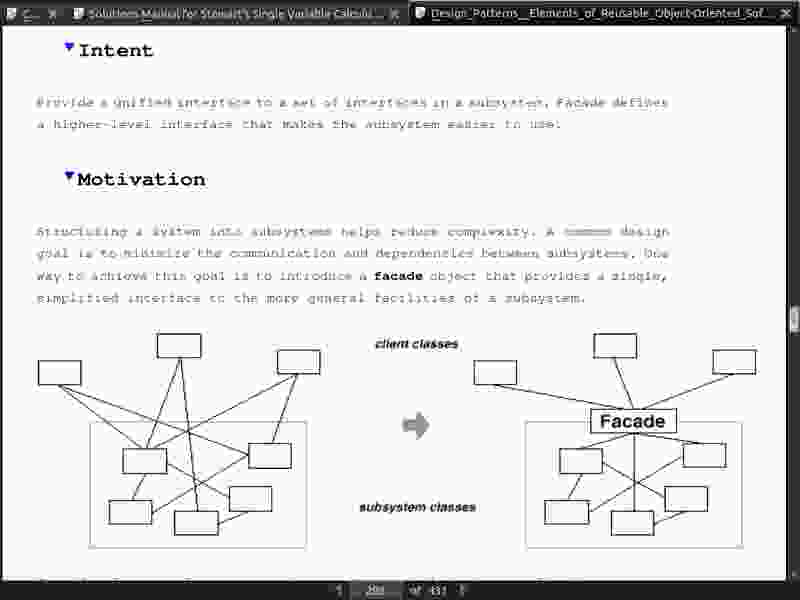
page 246:
-
Adapter focuses on resolving incompatibilities between two existing interfaces. It doesn’t focus on how those interfaces are implemented,nor does it consider how they might evolve independently. It’s a way of making two independently designed classes work together without reimplementing one or the other. Bridge, on the other hand, bridges an abstraction and its (potentially numerous) implementations. It provides a stable interface to clients even as it lets you vary the classes that implement it. It also accommodates new implementations as the system evolves.
-
As a result of these differences, Adapter and Bridge are often used at different points in the software life cycle. An adapter often becomes necessary when you discover that two incompatible classes should work together, generally to avoid replicating code. The coupling is unforeseen. In contrast, the user of a bridge understands up-front that an abstraction must have several implementations, and both may evolve independently. The Adapter pattern makes things work after they’re designed; Bridge makes them work before they are.
· 05: Behavioral Patterns
page 249:
- Behavioral patterns are concerned with algorithms and the assignment of responsibilities between objects. Behavioral patterns describe not just patterns of objects or classes but also the patterns of communication between them. These patterns characterize complex control flow that’s difficult to follow at run-time.
page 310:
- A mediator replaces many-to-many interactions with one-to-many interactions between the mediator and its colleagues.
page 327:
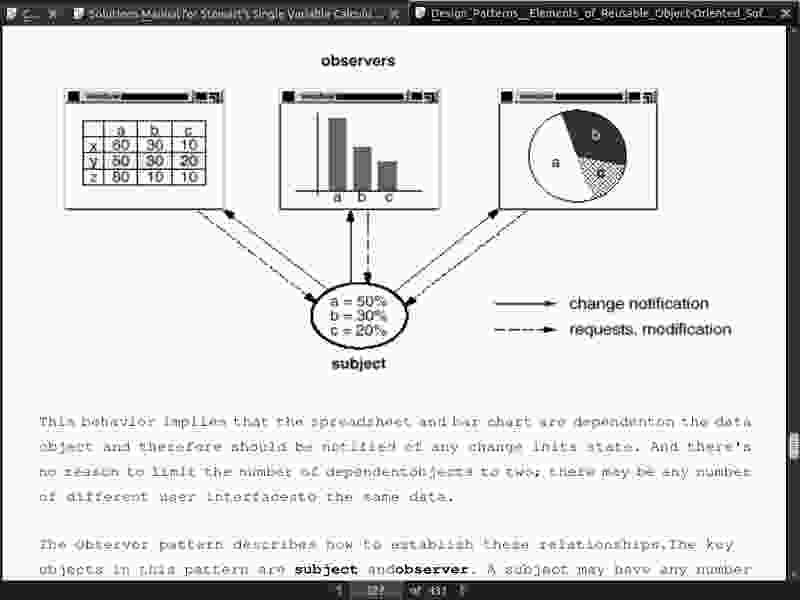
page 342:
- The key difference between table-driven state machines and the State pattern can be summed up like this: The State pattern models state-specific behavior, whereas the table-driven approach focuses on defining state transitions.
· 06: Conclusion
page 393:
- Christopher Alexander is the architect who first studied patterns in buildings and communities and developed a “pattern language” for generating them.
page 431:
